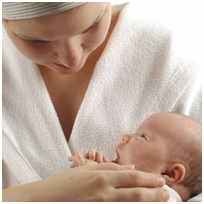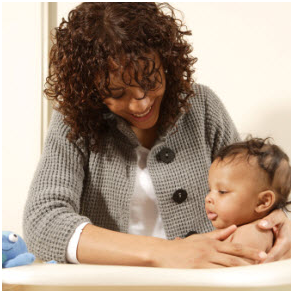NEWBORN CARE
How to hold your new baby

Most of us instinctively want to hold and cuddle our babies, but some new parents are nervous about it, feeling that babies must be very fragile.
Your baby will enjoy being held close to you, but won’t like being moved from one position to another very suddenly, so keep movements smooth and gentle.
· When you pick up your new baby, keep the head and neck supported – babies can’t control the heavy weight of their head on their own yet.
· Keep the head supported while you hold them, too, whether it’s close against you or upright, with their head on your shoulder.
· Hold your baby securely – if you feel confident, they will, too. As they grow, you will find that they becomes stronger and can hold their own head up for short periods of time. At this stage they may be happy being held over your shoulder where they can see the world, but also rest their head if they get tired.
· If your baby likes to be held a lot, find a sling that is comfortable and easy to use. That way, your baby stays close, while your hands are free to get on with other things.
How to bath a baby

Your midwife will be able to show you how to give your baby his first bath. When you feel ready to try on your own, follow our 10 simple steps.
1. Make sure the room is warm and that you’re not in a rush, or likely to be interrupted. Choose a time when your baby isn’t too hungry or too tired, then bath time can be more enjoyable.
2. Fill the baby bath with about 10 centimetres (four inches) of water at about 36°C (96°F). It should feel warm but not hot to your skin. Check by dipping your elbow in it. Collect everything else you will need: Two warm, dry towels, a clean nappy, sponge or a flannel, a ph neutral baby soap, when needed.
3. If your baby has a tendency to dry skin, there is no need to use soap. Water alone will do the job of cleaning your baby in the first few weeks.
4. Undress your baby but keep his nappy on. Wrap him in a warm towel, folded over at the back so you can easily cover his head with it afterwards.
5. You can wash your baby’s hair now. Tuck him under your arm and support his head with your hand. Hold him face-upwards over the bath. Tip your baby downwards slightly so that the water won’t run into his eyes. Using your other hand, pour some water over his hair and massage this in. Rinse your baby’s hair with the warm water. Pat his head dry with a warm towel.
6. Unwrap the towel covering your baby, remove his nappy and put the towel nearby. You will need it to wrap him in when he comes out of the bath. Place one arm under your baby’s back, so that his head and back rest against the bend of your elbow, and your hand has a firm grip on the arm furthest away from you. Then use your free hand to support your baby’s legs and bottom while you lift him into the bath.
7. Wash him and sprinkle water over him to keep him warm so that he can enjoy the sensation.
8. Rinse him well with the sponge or flannel to get rid of all the soapy bits.
9. Lift him out of the bath onto the towel on your lap and wrap him up to keep him warm.
10. Pat your baby dry and then dress him. Put him somewhere safe while you sort out the bath things.
Tips for bathtime safety
1. Have everything you need ready to hand before you begin.
2. Always put cold water in the bath first.
3. Make sure that hot and cold water are thoroughly mixed before testing the temperature.
4. Use your elbow - never your fingers - to check that the water is not too hot.
5. A bath thermometer should not read more than 36°C (96°F).
6. The water should be about 10 centimetres (four inches) deep.
7. Never leave your baby alone in the bath. A small baby can drown in a few inches of water.
8. If the telephone or doorbell rings, ignore it, or take your baby with you, wrapped in a thick towel.
9. Keep the umbilical area clean and dry.
10. Always wipe baby girls from front to back to avoid transferring bacteria from the anus to vagina.
11. NEVER pull back the foreskin on a baby boy - it won't separate from the penis for months.
12. Try using a bath support to hold your baby at an angle in the water so you have both hands free.
13. Bathing your baby when your partner/relative/friend is around if possible. It’s much easier if someone else can hand you things.









